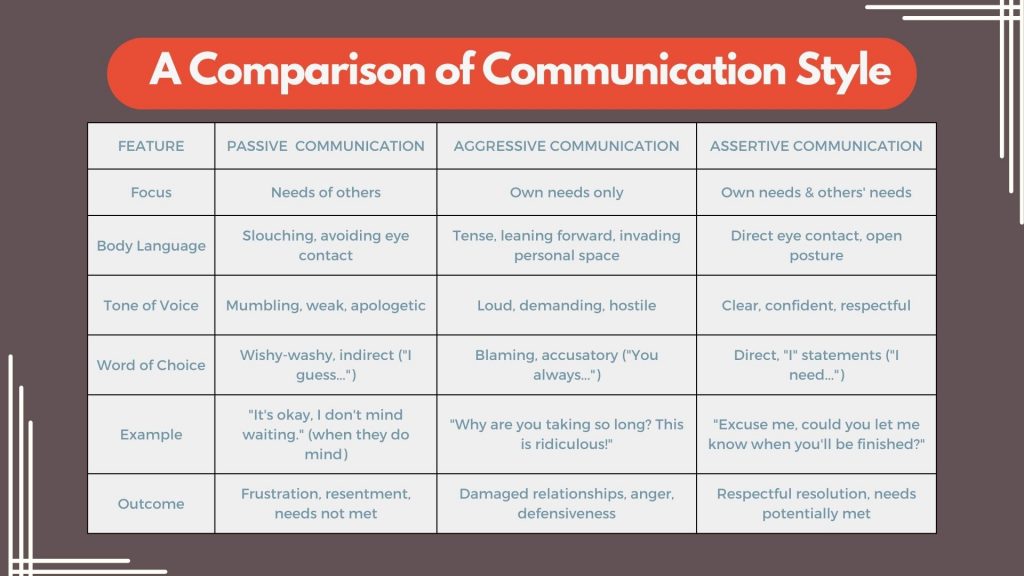Assertive Communication Training For Managers In 5 Clear Steps
You’re leading a brainstorming session brimming with creative energy. Suddenly, a team member throws out an idea that derails the momentum, taking the discussion off course. How do you refocus the conversation while still valuing their input? Or perhaps you need to deliver constructive feedback to an employee who’s missed deadlines. How do you express your concerns clearly and directly without appearing harsh or critical? These are just a few of the everyday challenges managers face. But what if there was a toolbox filled with communication strategies to handle these situations effectively? Assertive communication training equips you with the tools and techniques to navigate even the most challenging interactions with confidence. In this blog post, we’ll break down assertive communication training into 5 clear steps, empowering you to become a more confident and effective leader.- Assertive Communication Training For Managers In 5 Clear Steps
- Other Related Blogs
Understanding Assertive Communication
Picture this: You’ve just brainstormed a fantastic marketing campaign with your team. Everyone’s excited, but then a colleague suggests a completely different direction, derailing the momentum. How do you respond? Do you simply nod along, hoping they’ll eventually get on board (passive approach)? Or do you launch into a passionate defense of your idea, potentially shutting down others’ input (aggressive approach)? There’s a sweet spot between these two extremes: assertive communication. It’s about expressing your ideas clearly and confidently, while also respecting the thoughts and feelings of others. It’s the “I win, you win” scenario that fosters collaboration and gets things done. Now, let’s compare assertive communication to its not-so-helpful cousins:- Passive communication: Imagine you constantly agree with everyone, even when you have a different opinion. This might seem like the peaceful route, but it can lead to frustration and resentment. You bottle up your needs, and your team misses out on your valuable perspective.
- Aggressive communication: On the other hand, maybe you tend to steamroll over others with your ideas. While this approach might get things moving quickly, it can damage relationships and create a tense work environment.

Key Elements of Assertive Communication
Imagine this: you need to deliver some constructive feedback to an employee, John, who’s been missing deadlines. How do you ensure your message is clear, well-received, and actually leads to improvement? Here’s where the magic of assertive communication comes in. It’s about striking a balance between expressing your needs directly (crystal clear communication) and respecting John’s feelings (respecting boundaries). Let’s break down how these elements come together in this situation:- Clear Communication: Ditch the vague hints and say exactly what’s on your mind. Instead of muttering, “Ugh, these reports are late again,” try a direct approach: “John, I noticed the reports haven’t been meeting the deadlines lately. Can we discuss some strategies to get back on track?” This ensures your message is understood and avoids any room for misinterpretation.
- Active Listening: Assertive communication isn’t a one-way street. After you deliver your clear message, it’s crucial to actively listen to John’s perspective. Pay close attention to his response, ask clarifying questions like, “What challenges have you been facing that are causing the delays?” and acknowledge his feelings. This shows respect and opens the door for a more productive discussion.
- Respecting Boundaries: Assertiveness doesn’t mean being a bulldozer. John might feel defensive or overwhelmed. Maintain a respectful tone throughout the conversation. If he gets flustered or tries to deflect blame, you can use phrases like, “I understand this might be frustrating, but let’s focus on solutions together.” This sets a clear boundary for the conversation while still being respectful.
Why should Managers Learn Assertive Communication?
Assertiveness is one of the defining features of an effective leader. Communication in an assertive style helps managers in many ways, a few of which are as follows:- Assertive communication is an effective way to resolve conflicts and maintain healthy relationships at work.
- It can help managers be more effective in their work by improving communication, assertiveness, and relationship skills.
- Assertive communication skills can help managers build better working relationships with their employees by practicing more positive body language and tone of voice.
- Communicating assertively can help managers resolve workplace conflicts quickly and effectively. By having the ability to communicate assertively, managers can communicate their thoughts and feelings clearly and directly, which can lead to more effective solutions.
- Learning assertive communication skills can benefit the manager and the employee by assertively expressing opinions and listening respectfully to others’ views. This skill can help managers create a positive work environment for everyone involved.
Key Components of Assertive Communication Training
So, you’re ready to take charge and become a more assertive communicator. But what exactly does assertive communication training entail? Here’s a breakdown of the key components that will equip you with the skills and confidence to navigate any situation:- Self-awareness is Key: The journey begins with understanding yourself. Assertive communication training will help you identify your communication style (passive, aggressive, assertive) and any personal roadblocks that might hinder assertiveness (fear of conflict, people-pleasing tendencies). This self-reflection is crucial for building a strong foundation.
- The Power of “I” Statements: You’ll learn to express your needs and feelings clearly and directly without blaming or aggression. Mastering “I” statements is a game-changer. Instead of saying, “You always interrupt me,” try, “I feel frustrated when I’m cut off mid-sentence. Can we let each other finish speaking?” This approach fosters empathy and keeps the focus on the issue at hand.
- Body Language & Tone: Communication goes beyond words. Assertive communication training will help you decode and harness the power of nonverbal cues. Maintaining good eye contact, using confident body language, and speaking in a clear, steady tone will project your message with authority and professionalism.
Assertive Communication Training for Managers with Risely
Be Vocal about Your Boundaries
The first step in learning assertive communication is understanding and asserting your boundaries. This means being vocal about what you expect from others, both in behavior and communication style. Your assertiveness will let others know that you will not be pushed around or taken advantage of, which can prevent conflicts before they happen. When communicating with someone who may have violated your boundary, it is important to remain calm and speak to avoid misunderstanding, Do not accuse the person of deliberately violating your boundary; instead, state plainly the problem and ask them nicely to stop doing this. If they do not comply, be prepared to take action. When communicating with others, make sure your words are precise and clear, so there are no misunderstandings or surprises later on down the line. Be concise when conveying your thoughts so everyone can understand what you are saying. Try not to use aggressive language or personal attacks, as this will only deepen the conflict and damage relationships. It may seem counter-intuitive, but one of the best ways to assert yourself and improve communication is by listening carefully. When someone is speaking, give them your full attention without interruption. Instead, take in their words, emotions, and intentions – don’t just focus on what you want to say next. This way, you can better understand why they are communicating the way they are and how to respond appropriately.Assertive Communication Skill
Assertive communication is a skill that allows people to communicate effectively and productively by setting boundaries and setting expectations. It can be used in various situations, including working with others in a formal setting, interacting with teams and clients, and resolving conflicts. You can read more about the assertive communication skill here:- What is assertiveness?
- What is assertive communication for managers?
- Why do managers need assertive communication?
Assertive Communication Assessment
Starting any journey begins with assessing the present status. With that spirit in mind, any assertive communication training program for managers, whether online or offline, should begin with an assessment of the existing skillset of the manager. Risely offers free assertive communication assessment for managers to understand the intricacies of their skills. Highlighting the strong and weak areas effectively helps managers identify where they need to work. After taking the assessment, you will know exactly where to begin. So get started for free with the assertive communication assessment now! Assertive communication training for managers with Risely can help them identify their strengths and weaknesses in assertive communication. This assessment can help managers use assertive communication techniques more effectively in the workplace. After completing assertive communication training, managers will know how to identify situations where they need to use assertive communication techniques and how to do so effectively. As a result, managers can better facilitate productive work interactions within their teams by improving their assertiveness skills.Other Interesting Reads
Assertive Communication Toolkit
The assertive communication toolkit by Risely is a manager’s handy guide to learning assertive communication without coming across as aggressive. It starts by elaborating on the importance of assertive communication for managers who want to transform into charismatic leaders. Further, it clarifies a critical detail of assertive communication – how it differs from aggressive communication. Then, as you move further, the toolkit describes step-wise procedures for managers to improve assertive communication skills. But that’s not all; the free assertive communication toolkit offers more, and you can grab your copy here! Risely offers helpful content on assertive communication designed to help managers improve employee interactions. These blogs cover a wide range of assertiveness skills, including handling difficult conversations, resolving conflicts, and building better relationships. They also cover more advanced topics, such as how to facilitate a behavior change and how to promote and support a team.Grow more with Risely!
Take the next step in your career with Risely for the effective growth of core leadership skills. In addition to assertive communication, Risely helps managers develop critical leadership skills that beat 30+ people management challenges that team managers commonly face. Risely is an AI-based leadership coaching platform for managers who want to shine with their teams. It helps managers develop learning journeys that are as unique as themselves! Designed to suit you and your needs, Risely becomes your buddy in overcoming problems holding back your team. Start your 14-day free trial now!Conclusion
Managers should use assertive communication techniques when necessary to maintain productive work interactions. The assertive communication toolkit by Risely offers helpful tips and tricks for improving skills without requiring aggressive behavior. In summary, assertive communication training for managers is vital to help them communicate assertively with others and feel more in control of the situation. If you’re looking for assertive communication training to help you grow and advance in your career, Risely is a perfect choice. Check out “Assertiveness vs. Aggressiveness: How to be an effective leader?“Test your all round communication skills in just a few minutes
Start the communication skills assessment for managers to get detailed insights
Other Related Blogs
Assertive Feedback Techniques ft. Gurleen Baruah
Assertive Feedback Techniques ft. Gurleen Baruah Let’s be real—giving feedback as a manager isn’t always easy. Say too little, and nothing changes. Say too much, and it might come off…
Assertive Conflict Resolution Techniques | Brenda Hooper
Assertive Conflict Resolution Techniques | Brenda Hooper Can assertive communication help you out in resolving conflicts? In this podcast conversation, we have Brenda Hooper, an experienced executive coach joining us…
The Best Assertiveness Coaches To Transform The Way You Interact
The Best Assertiveness Coaches To Transform The Way You Interact Effective communication is paramount in the dynamic world of business and leadership. Yet, finding the balance between being passive and…
Assertive Communication for Managers: 5 Hacks to Master the Skill
Assertive Communication for Managers: 5 Hacks to Master the Skill A manager’s communication skills can make or break the success of an organization. From leading others and making crucial decisions…


